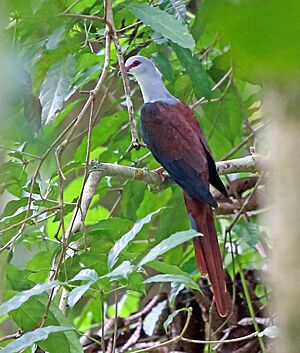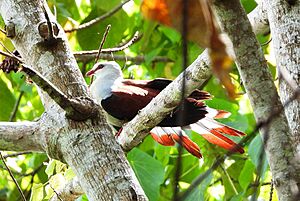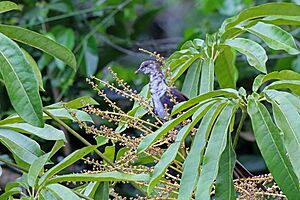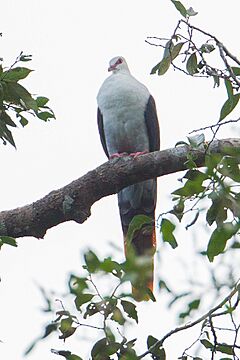Great cuckoo-dove
Quick facts for kids Great cuckoo-dove |
|
|---|---|
 |
|
| R. r. reinwardti | |
| Conservation status | |
| Scientific classification | |
| Genus: |
Reinwardtoena
|
| Species: |
reinwardti
|
 |
|
| Range (year-round) | |
| Synonyms | |
|
List
Columba reinwardtsi Temminck, 1824
Macropygia reinwardtii (Temminck, 1824) Reinwardtoena typica Bonaparte, 1854 Reinwardtoena reinwardtsi (Temminck, 1824) Turacoena reinwardtii (Temminck, 1824) Ectopistes reinwardtii (Temminck, 1824) Turtur reinwardtii (Temminck, 1824) Coccyzoenas reinwardtii (Temminck, 1824) Reinwardtoena reinwardtii obiensis Hartert, EJO, 1898 Reinwardtoena reinwardtii albida Hartert, EJO, 1900 |
|
The great cuckoo-dove (Reinwardtoena reinwardti) is a large bird in the pigeon family. It was first described in 1824 by a Dutch zoologist named Coenraad Jacob Temminck. You can find this bird in New Guinea, some nearby islands, and a region called Wallacea. It mostly lives in old, untouched forests and at the edges of forests.
This pigeon is quite big and easy to spot. It can be about 47.5 to 52.5 centimeters (18.7 to 20.7 inches) long and weigh between 208 and 305 grams (7.3 to 10.8 ounces). Adult great cuckoo-doves have a whitish or blue-grey head, neck, and chest. Their undersides are pale bluish-grey, while their upper parts are chestnut-brown. The outer parts of their wings are black. Female birds have yellower eyes and duller skin around their eyes than males. Young birds are mostly dull grey-brown.
Great cuckoo-doves eat fruits and seeds. They are usually seen alone or in pairs. However, they will gather in groups with other fruit-eating birds at trees full of fruit. They are known to protect the fruit bushes they are eating from other birds. This is a rare behavior for birds. They breed all year round, but the busiest time for breeding on New Guinea is from October to December. Their nests are flat platforms made of sticks, moss, and ferns. They lay only one white egg. The International Union for Conservation of Nature (IUCN) lists the great cuckoo-dove as a species of least concern. This means its population is stable and its habitat is large enough.
Contents
About the Great Cuckoo-Dove
The great cuckoo-dove was first named in 1824. It was called Columba reinwardtsi by Coenraad Jacob Temminck. He studied a bird from Ambon Island, Indonesia. The name reinwardtsi was a mistake. Temminck himself later used the spelling reinwardtii.
In 1854, a French bird expert, Charles Lucien Bonaparte, created a new group (called a genus) for this bird. He named the group Reinwardtoena. Both the group name and the bird's specific name honor a Dutch scientist, Caspar Georg Carl Reinwardt. The official common name for this bird is "great cuckoo-dove." This name was chosen by the International Ornithologists' Union (IOU). Other names for it include long-tailed cuckoo-dove and giant cuckoo-dove.
The great cuckoo-dove is one of three species in the Reinwardtoena group. All three are part of the pigeon family. It looks very much like the pied cuckoo-dove. These two birds are sometimes thought of as very close relatives. The IOU currently recognizes three types, or subspecies, of the great cuckoo-dove:
- R. r. reinwardti: This is the main type. It lives on several islands in the Maluku Islands of Indonesia.
- R. r. griseotincta: This type is found on New Guinea and its nearby islands. It is larger and darker than the main type. Its white color is only on its forehead, face, and throat.
- R. r. brevis: This type lives on Biak and Supiori islands. It is smaller and paler than the other types. It might even be a separate species.
What Does This Bird Look Like?
The great cuckoo-dove is a large pigeon with a long tail. It measures about 47.5 to 52.5 centimeters (18.7 to 20.7 inches) long. It weighs between 208 and 305 grams (7.3 to 10.8 ounces). It has a small crest on the back of its head. This makes its head look big.
The main type of this bird has a blue-grey or cream-white head, neck, and chest. This color turns purplish-grey on the back of its neck and upper back. Its throat and belly are white, sometimes with a pinkish tint. The back, rump, and upper tail feathers are chestnut-brown. Its wings are a darker chestnut-maroon color. They become blacker further from the body. The undersides of its wings are black.
The outer tail feathers are greyish-white with black bases and black stripes. The amount of chestnut color increases towards the center. The middle tail feathers are almost all chestnut. Male birds have yellowish-white eyes with a red outer ring. The skin around their eyes is reddish. Females have yellower eyes and duller skin around their eyes. Both males and females have a red to purplish-pink base to their bill. The rest of the bill is yellowish-brown, sometimes with a white tip. Their feet are pink to purplish-red.
Baby birds are pinkish-white when they first hatch. Older young birds have black bills and feet. Young great cuckoo-doves are dull grey-brown. Their throats and bellies are a dirty white. Their wings are darker than the rest of their body.
It's easy to recognize the great cuckoo-dove because of its large size. Its pale undersides stand out against its rich, dark upper parts. However, it can sometimes be confused with other cuckoo-doves. These other birds are smaller and have more striped undersides.
Bird Calls
The great cuckoo-dove makes two different sounds. One call is a repeated "cookuwook cookuwook cookuwook." It sounds like another type of cuckoo-dove, but it's slower. The second call is a series of about 12 deep "hoo" notes. These notes get deeper and faster towards the end. People have described this call as sounding like "insane laughter."
Where Do They Live?
The great cuckoo-dove lives in Papuasia and Wallacea. In Indonesia's Maluku Islands, you can find it on several islands like Buru and Ambon. On New Guinea, it lives across most of the main land. It also lives on nearby islands like Waigeo and Biak.
This bird mostly lives in old, untouched forests and at the edges of forests. On Biak, it also lives in forests that have been logged. It can be found at high elevations, up to 3,380 meters (11,090 feet) on New Guinea. On the Maluku Islands, it lives from 115 to 1,400 meters (377 to 4,593 feet) high. It is most common above 800 meters (2,600 feet).
How Do They Behave?
Great cuckoo-doves are usually seen alone or in pairs. They stay in the middle or upper parts of the forest. They might form groups of up to ten birds at fruit trees. Sometimes, they join groups of other fruit-eating birds. They usually fly under the forest canopy. Their wingbeats are slow, powerful, and graceful, but they fly fast.
What Do They Eat?
The great cuckoo-dove eats fruits and small seeds. They especially like plants from the Araliaceae family. They usually eat in the treetops, but sometimes they eat on the ground. They have been seen protecting fruit bushes while they eat. They scare away other birds that try to eat from the same bush. This includes birds-of-paradise and honeyeaters. The dove attacks other birds by loudly clapping its wings together. It tries to land on the bird that is bothering it. Protecting food sources like this is not common for birds. It only happens when there's a medium amount of fruit and a moderate number of other birds visiting. These doves have also been seen eating soil. Some have even been found with small stones in their stomachs.
Reproduction and Life Cycle
When a great cuckoo-dove wants to attract a mate, it flies in a special way. It flies sharply upwards, spreads its wings and tail, or claps its wings together at the top of its flight. Then it drops sharply downwards. Another display involves flying up from a branch in a wide circle before returning.
They can breed all year round. The breeding season changes in different places. On New Guinea, breeding seems to happen throughout the year. It is thought to be busiest from October to December. Their nests are flat or slightly curved platforms. They are made of sticks, moss, roots, and ferns. The inside is lined with soft plant material. Nests are usually in a tree or bush, about 1.2 to 5 meters (3.9 to 16.4 feet) high. Some nests have been seen as high as 12 meters (39 feet) in certain palm trees. They sometimes build nests on rocky ledges in caves or river canyons.
Great cuckoo-doves lay only one white egg. The egg measures about 37.1–40.0 by 25.0–26.8 millimeters (1.46–1.57 by 0.98–1.06 inches). If birds in captivity lose their first egg, they will lay more. Both parents may sit on the egg to keep it warm. In captivity, eggs hatch after 16 days. In the wild, it takes 22 days. Young birds are cared for until 13 days after hatching. They leave the nest 25 days after hatching. Young birds start finding their own food 35 days after hatching.
Dangers to the Great Cuckoo-Dove
Some tiny creatures called feather lice can live on these birds. The pygmy eagle might also hunt them.
Status and Conservation
The International Union for Conservation of Nature (IUCN) says the great cuckoo-dove is a species of least concern. This means it is not currently in danger. Its population is stable, and it has a large area to live in. We don't know the exact number of these birds. However, they are generally not very common. They can be more common in hilly and mountainous areas. In Papua New Guinea, there are about 4 to 6 birds per square kilometer in one wildlife area. On Seram Island, they are rare in low areas but common at higher elevations.






